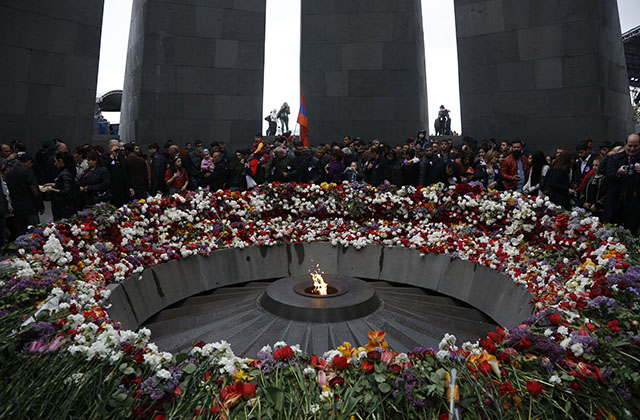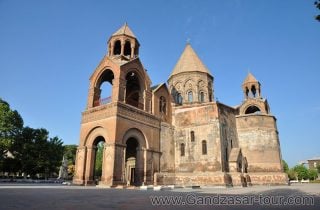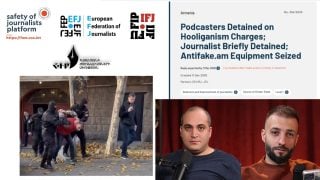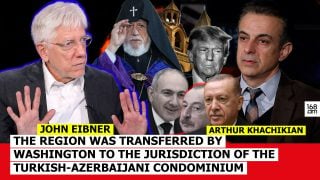
Pope Francis to Visit Armenia’s Memorial to ‘Genocide’ Victims

Pope Francis travels Friday for a three-day trip to Armenia, where he will visit the memorial to those who died in the 1915 massacre of Armenians by Turks, potentially straining relations between the Vatican and Ankara again.
The trip also comes just after a major outbreak of violence in the turbulent Caucasus region, when ethnic Armenian separatists fought Azerbaijani forces for four days in April over the breakaway region of Nagorno-Karabakh.
The main question when Pope Francis goes to the Tsitsernakaberd Memorial Complex in the Armenian capital of Yerevan on Saturday is whether he will echo his description last year of the mass killings by Ottoman forces as the “first genocide of the 20th century.”
Turkey responded to the 2015 statement, made during a commemorative Mass in St. Peter’s Basilica, by immediately recalling its ambassador to the Vatican to Ankara for consultations. It took 10 months before the ambassador returned. Turkish PresidentRecep Tayyip Erdogan condemned the pope’s statement and warned him “not repeat this mistake.”
St. John Paul II used the word genocide in the Armenian context during his own 2001 visit to Armenia, in a joint declaration with Catholicos Karekin II, head of the Armenian Apostolic Church, who will also host Pope Francis.
But Pope Francis went further by calling the massacre of Armenians one of “three massive and unprecedented tragedies” in the 20th century, along with the Holocaust and the 1932-33 man-made famine in Ukraine and other parts of the Soviet Union.
Pope Francis also linked the 1915 killings to latter-day attacks elsewhere on “our defenseless brothers and sisters who, on account of their faith in Christ or their ethnic origin, are publicly and ruthlessly put to death—decapitated, crucified, burned alive—or forced to leave their homeland.” Armenia is predominantly Christian, although Roman Catholics are few.
The pope has been highly vocal about the persecution of Christians, especially in Muslim-majority countries, and has called on Muslim leaders to denounce the actions of Islamic State militants in Syria and Iraq. However, he recently rejected the term genocide for the plight of Christians in the Middle East in favor of the religious term martyrdom.
In March, U.S. Secretary of State John Kerry accused Islamic State of committing genocide against minorities including Yazidis and Christians.
Pope Francis has invoked the persecution of Christians as a motive for closer ties with other Christian churches, often speaking of their bonds in an “ecumenism of blood.”
Such concerns helped make possible the meeting in February between Pope Francis and Patriarch Kirill of Moscow—a first between the leaders of the Catholic and Russian Orthodox churches. A joint declaration by the two leaders in Havana gave prominent mention to the persecution of Christians “in many countries of the Middle East and North Africa.”
Tensions between Armenia and another neighbor—Azerbaijan—will also hang over the visit. The two former Soviet republics have fought over the Nagorno-Karabakh region, an ethnic Armenian enclave within predominantly Muslim Azerbaijan that was overtaken by Armenia during a six-year war that ended with a 1994 cease-fire.
The recent outbreak of fighting—the worst in decades—began when Azeri forces broke through Armenian lines in a bid to retake strategic heights. The two sides accuse each other of ongoing shelling.
The presidents of the two countries met with Russian President Vladimir Putin on Monday in St. Petersburg, the Kremlin said. In a joint statement, they said they had agreed to increase the presence of international observers in the conflict zone, and that they were satisfied with the implementation of the cease-fire.
The pope will visit Azerbaijan together with Georgia this fall, Sept. 30-Oct. 2. The Vatican is officially presenting the two trips as parts of a single trip to the Caucasus, which will be completed in the fall.
Pope Francis’ visit will be an opportunity to strengthen ties with the Armenian Apostolic Church, one of the Oriental Orthodox Churches. It is separate from the far larger group of Eastern Orthodox Churches, including Russia, who are in communion with the Ecumenical Patriarch of Constantinople.
The Catholic and Armenian Apostolic churches have been separated since the fifth century.
Catholics number only about 280,000 in Armenia, a country of almost 3 million. The church wasn’t even recognized officially until 1992, following independence from the Soviet Union.
Before leaving on Sunday, Pope Francis is to pray at the Khor Virap monastery, near the border with Turkey, within sight of Mount Ararat. He will be only about 15 minutes from the Turkish border, which is officially closed, though Armenians frequently cross to work in Turkey.
A border visit isn’t on the schedule, but such a gesture would be in character for a pope who likes surprising people. During a visit to the Holy Land in 2014, Pope Francis made an unscheduled stop to pray at the Israeli separation barrier on the West Bank.
If Pope Francis does go to the Turkish border, it will likely prove the visual news highlight of his visit, similar to his stop at the U.S. border during his February 2016 visit to Mexico, when he prayed for migrants who had died trying to cross the Rio Grande.
By Francis X. Rocca























